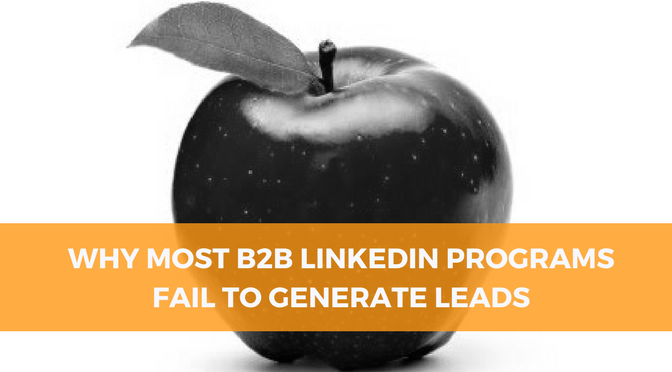Why Most B2B LinkedIn Programs Fail to Generate Leads
If I were to visit your website and click on the LinkedIn icon would it take me to your company page where you post summaries and links to your blog articles and press releases? Would I see that you have a healthy number of followers and many of your employees have their personal profiles connected to your page? If I looked at your profile or that of your CEO or top sales people or thought leaders would I see fairly active status updates - usually in the form of automatic posting of blog articles? Would I run across you occasionally in a group?
Did I just describe your LinkedIn program?
If your answer is yes, congratulations. You’ve made it to the 2nd phase of LinkedIn participation – brand maintenance. You’re ahead of a lot of tech companies and right in there with > 80% of those companies that have organized LinkedIn programs.
Here’s some reality: You’re not going to generate many leads this way; and you’re missing a big opportunity.
Why brand maintenance doesn’t generate leads.
There’s a faulty assumption in the planning and implementation of programs like the one I describe above. These brand maintenance programs assume viable prospects and influencers are so interested in what you’re doing they’ll actually look for your stuff among the jillions of status updates and blog article group postings they face every time they log onto LinkedIn. In most cases, this just isn’t true.
In reality, if you want to connect with qualified potential buyers, strategic partners, industry influencers or the media, drive high quality traffic to your website or landing page, and generate offline conversations for your business development or sales team, you’re going to have to work a little harder.
What’s missing from brand maintenance LinkedIn programs.
Brand maintenance programs don’t generate leads because they’re too passive and lack key components that lead to real results. Take a look at any truly successful LinkedIn demand generation program. Here’s a list of the critical elements you’ll find.
Strategy. Just like any other marketing program, a productive LinkedIn program needs a strategy and a plan for execution. This strategy includes measurable, sales-supporting goals and objectives, an understanding of who you are targeting with this program, identification of a LinkedIn team (marketing, sales, subject matter experts, executives), positioning and messaging and a method of evaluating program performance.
Outreach. With 300 million members and counting, there is simply too much noise on LinkedIn to sit back and hope buyers find your status updates. Instead, you need to locate your target audience and reach out often – with connection invitations, one-on-one messages and group communication.
Nurturing / Development. Just like in the non-LinkedIn world, the vast majority of potential buyers are not yet ready for a demo when they first engage with you. And, just like in the non-LinkedIn world, a vast majority of those people are going to buy eventually and it will be from the people who stay in touch in a non-annoying, helpful way. To be effective from a sales and marketing perspective, a LinkedIn program needs a prospect development component.
Hand-off. Relationships can be established and grown on LinkedIn, but this is not where the sale is finalized. The ultimate goal of a good LinkedIn program is to move the relationship off of LinkedIn and into your marketing funnel or onto the call calendar of your sales people.
Back to brand maintenance
This is not to say that brand maintenance programs don’t have some value. If a prospect does come looking for you, they’ll find professional looking pages, indications of active participation and lots of employees represented on the network. This is good because prospects will check you out at various stages of the buying process and these are things they’ll be looking for. Just don’t be waiting around to count the leads.
Forward to lead generation
I’ll say it again. In today’s highly competitive marketplace, it’s simply not aggressive enough to sit back and wait for prospects to find and read your status updates. Marketers who are willing to push their programs to actively tap into the LinkedIn network will find it to be a tremendous source of the highest quality leads. In fact, in one program for a large AV integrator, we used LinkedIn to generate more leads than their pay-per-click, email marketing, telemarketing and display advertising efforts combined. Read how we generated more leads on LinkedIn.
If you like this article join the other forward thinking technology marketers who get our blog updates every week. Click here to subscribe to our blog updates.

